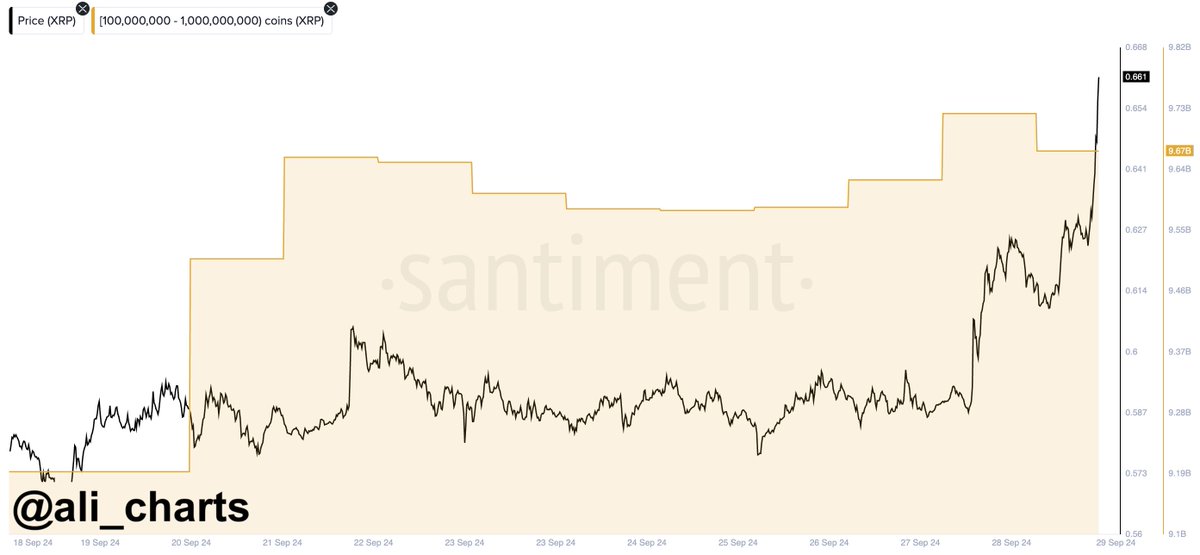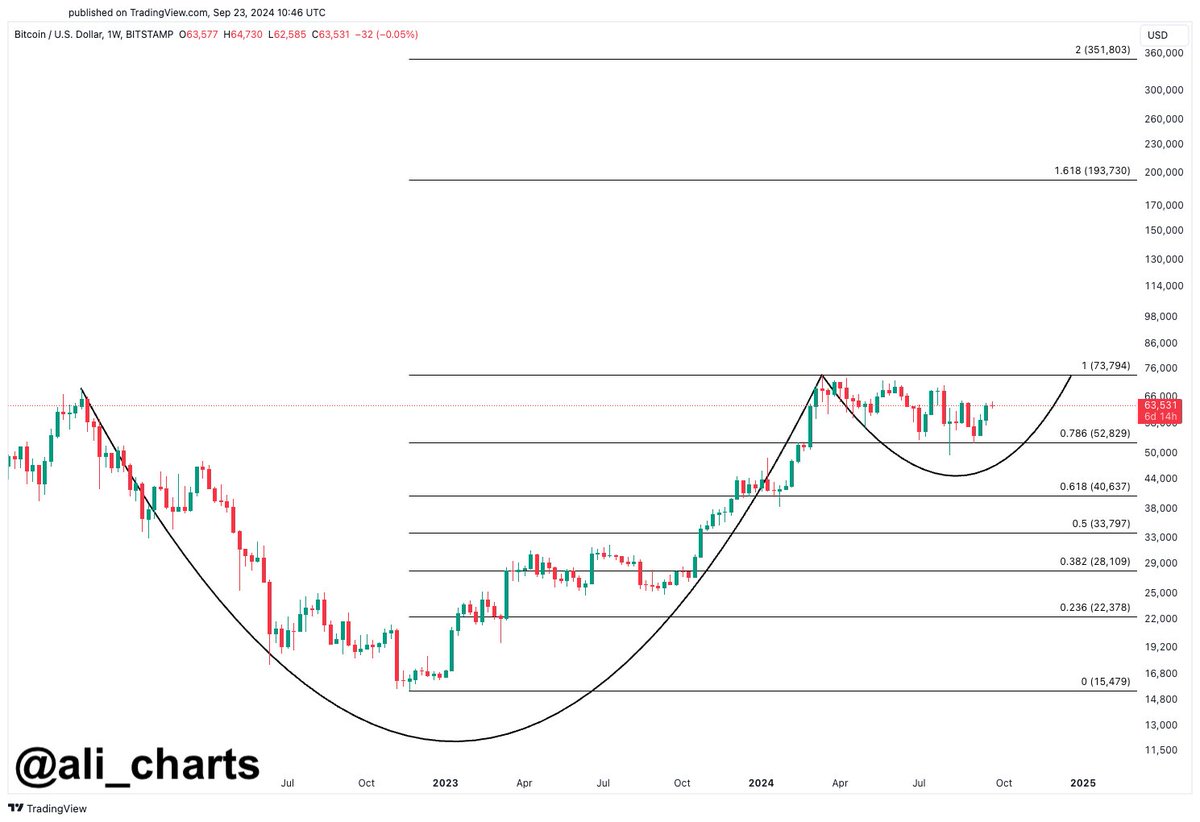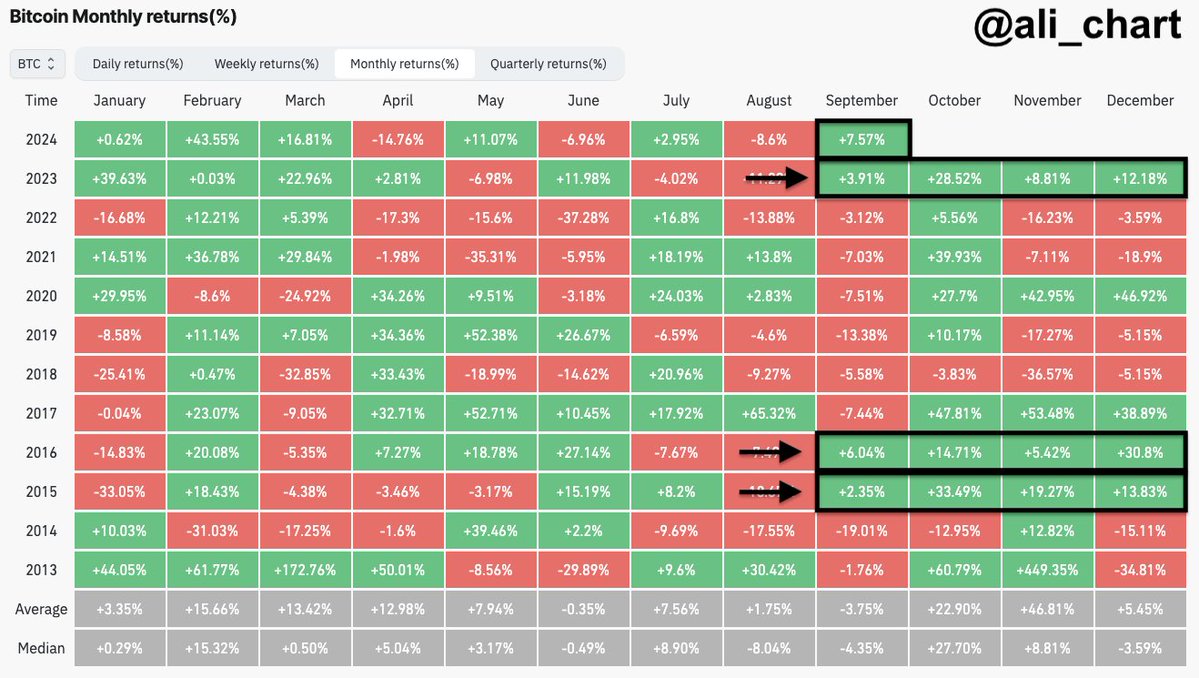News
Crypto Whales Gobble Nearly $300,000,000 Worth of XRP in Just 10 Days, Says Analyst
Published
2 months agoon
By
admin
Deep-pocketed investors have been busy accumulating massive amounts of XRP since September 20th, according to a popular crypto analyst.
Ali Martinez tells his 72,900 followers on the social media platform X that crypto whales bought $286.7 million worth of XRP, the token used to operate Ripple Labs’ payments platform, within 10 days.
“Ripple whales have bought over 470 million XRP in the past 10 days [as of September 29th]!”

XRP is trading for $0.61 at time of writing, down 3.4% in the last 24 hours.
Next up, the analyst says Bitcoin (BTC) may be forming a cup-and-handle pattern on the weekly chart.
A cup-and-handle formation is typically viewed as a bullish continuation pattern, suggesting that an asset is taking a breather after a steep rally before taking out a key resistance level.
“Current price action is just noise! If Bitcoin is truly forming a cup-and-handle pattern, the long-term bullish target could range between $194,000 and $352,000!”

The analyst also says that based on historical price data Bitcoin may finish the year in an uptrend.
“Historically, when Bitcoin closes September in the green, the final three months of the year have seen even bigger gains!”

Bitcoin is trading for $63,254 at time of writing, down 2.9% in the last 24 hours.
Don’t Miss a Beat – Subscribe to get email alerts delivered directly to your inbox
Check Price Action
Follow us on X, Facebook and Telegram
Surf The Daily Hodl Mix
 

Disclaimer: Opinions expressed at The Daily Hodl are not investment advice. Investors should do their due diligence before making any high-risk investments in Bitcoin, cryptocurrency or digital assets. Please be advised that your transfers and trades are at your own risk, and any losses you may incur are your responsibility. The Daily Hodl does not recommend the buying or selling of any cryptocurrencies or digital assets, nor is The Daily Hodl an investment advisor. Please note that The Daily Hodl participates in affiliate marketing.
Generated Image: DALLE
Source link
You may like


Where to Invest in November End?


XRP Price Hits 3-Year High At $1.6


Australia seeking advice on crypto taxation to OECD


Crypto Trader Records $2.5M Profit With This Token, Here’s All


Trump taps crypto bros to be in charge: What’s at stake?


Charles Schwab Looking at Spot Crypto Trading Following Regulation Shift: Report
atm
Australia seeking advice on crypto taxation to OECD
Published
2 hours agoon
November 25, 2024By
admin

Australia, with the world’s most significant number of crypto ATMs, seeks advice from an international organization on implementing crypto taxation.
The Organization of Economic Cooperations and Development (OECD), which has invented taxation on digital assets framework, was asked by the Department of Treasury to share input by next January.
The input of the consultations has focused on comparing two options of crypto taxation: implementing the OECD’s Crypto Asset Reporting Framework (CARF) into their law or customizing the policy approach.
CARF is a taxation transparency framework for the international authorities to collect tax-related information from the providers, including crypto-asset purchases and specific consumer data for $50k above transactions. Tax authorities could also share the information with other authorities to gain related information.
“The CARF improves visibility of income from crypto assets. This helps increase compliance with local tax laws and deter tax evasion,” the government on report.
The consultations seek advice on whether the government should follow the same rules as the OECD or implement its own to target specific data needed. If the Australian government implements its own, it could add or remove particular information fields based on the tax authority.
CARF would apply the Reporting Crypto Asset Providers to several crypto companies, including crypto exchanges, wallet providers, brokers, dealers, and ATM providers.
Australia’s growing crypto industry
The Australian government is aware that the crypto industry is growing. This is reflected in the relatively high crypto adoption among their people, with one-fifth of their population identified as crypto holders.
Australian crypto holders last year also gained a profit of up to $9,627 on average, or an increase of 17% from 2022 profit, according to a Swyftx report. The number of people going to invest in crypto in the next year is projected to boost to more than 2 million people.
According to CoinATMRadar, the crypto automatic teller machines (ATM) in Australia also share a big amount, estimated at around 3,3% of the market share in the world. The ATM has spread into Australia’s top cities, including Sydney (441), Melbourne (311), Brisbane (201), and Perth (140).
The government has recently sought advice regarding the central bank digital currency or digital dollar.
Source link
charles schwab
Charles Schwab Looking at Spot Crypto Trading Following Regulation Shift: Report
Published
6 hours agoon
November 24, 2024By
admin
Financial services firm Charles Schwab is reportedly waiting for favorable conditions to offer cryptocurrency trading to its clients.
Charles Schwab’s incoming chief executive Rick Wurster says the Texas-based firm is eyeing to provide spot cryptocurrency trading services once regulations in the US become supportive of digital assets, reports Bloomberg.
Says Wurster in a Bloomberg Radio interview,
“We will get into spot crypto when the regulatory environment changes, and we do anticipate that it will change, and we’re getting ready for that eventuality.”
The US is expected to have a more friendly stance on crypto once President-elect Donald Trump assumes office. During his campaign, Trump vowed to support the digital asset industry.
Schwab already offers crypto-focused exchange-traded funds (ETFs) and digital asset futures.
The firm is looking at adding spot trading for digital assets as companies in the financial services space compete to roll out new product offerings to investors.
While Wurster says he’s not looking to get crypto exposure for now, he notes that he plans to support clients planning to invest in the digital asset space.
“Crypto has certainly caught many’s attention, and they’ve made a lot of money doing it. I have not bought crypto, and now I feel silly.”
Don’t Miss a Beat – Subscribe to get email alerts delivered directly to your inbox
Check Price Action
Follow us on X, Facebook and Telegram
Surf The Daily Hodl Mix
 

Disclaimer: Opinions expressed at The Daily Hodl are not investment advice. Investors should do their due diligence before making any high-risk investments in Bitcoin, cryptocurrency or digital assets. Please be advised that your transfers and trades are at your own risk, and any losses you may incur are your responsibility. The Daily Hodl does not recommend the buying or selling of any cryptocurrencies or digital assets, nor is The Daily Hodl an investment advisor. Please note that The Daily Hodl participates in affiliate marketing.
Generated Image: Midjourney
Source link
crime
Crypto cops record $8.2b in financial remedies for investors: SEC
Published
11 hours agoon
November 24, 2024By
admin

For all the complaints levied against the crypto-strict U.S. Securities and Exchange Commission (SEC), the agency successfully obtained orders for $8.2 billion in financial remedies for 2024.
This is despite a 26% decrease in total enforcement actions.
The successful prosecution of Terraform Labs helped the agency achieve this milestone. Once a jury verdict found Terraform Labs and founder Do Kwon liable for fraud, defendants agreed to a final judgment ordering them to pay more than $4.5 billion in penalties — the highest amount ever obtained by the SEC following a trial.
It accounted for more than half of the total monetary judgments, according to the details from the press release.
SEC’s 583 enforcement actions
The SEC’s enforcement efforts in 2024 showed significant shifts across multiple categories, with 583 total enforcement actions. This includes 431 stand-alone actions representing a 14% decrease, 93 follow-on administrative proceedings showing a 43% decrease, and 59 delinquent filing actions marking a 51% decline.
Despite the reduced number of cases, the financial impact reached these levels, combining $6.1 billion in disgorgement and prejudgment interest with $2.1 billion in civil penalties.
In the cryptocurrency sector, the SEC pursued several major cases, including charges against Silvergate Capital for misleading BSA/AML compliance disclosures and action against Barnbridge DAO for unregistered securities offerings.
The agency also tackled the HyperFund pyramid scheme involving $1.7 billion and the NovaTech fraud case affecting 200,000 investors. Notable first-time enforcement actions targeted relationship investment scams involving NanoBit and CoinW6 platforms.
The SEC’s Division of Enforcement won all five federal district court cases, including its crypto-related trial against Terraform Labs. This success extended to investor protection measures, with 124 individuals barred from serving as officers and directors of public companies.
SEC Chair Gary Gensler emphasized the Division’s role as a “steadfast cop on the beat,” while Acting Director Sanjay Wadhwa noted increased market participant cooperation and self-reporting.
The report somewhat justifies Gensler’s role as the top crypto enforcer. The outgoing SEC chair, set to resign on Jan. 20, faced harsh criticism from crypto enthusiasts and retail traders throughout his tenure for his regulatory approach.
And yet, the SEC distributed $345 million to harmed investors and processed a record 45,130 tips, complaints, and referrals, including over 24,000 whistleblower tips, resulting in $255 million in whistleblower awards.
The agency’s success in returning funds to investors has been substantial, with more than $2.7 billion distributed since fiscal year 2021.
But most of the actual scams were cyrpto 😬
— sean combs (@William48759211) November 22, 2024
Source link

Where to Invest in November End?

XRP Price Hits 3-Year High At $1.6

Australia seeking advice on crypto taxation to OECD

Crypto Trader Records $2.5M Profit With This Token, Here’s All

Trump taps crypto bros to be in charge: What’s at stake?

Charles Schwab Looking at Spot Crypto Trading Following Regulation Shift: Report

Here’s Why XRP Price Will Hit $20

3 cryptos under $0.5 that experts believe could deliver 1500% returns

Gemini’s Cameron Winklevoss Demands Fresh Probe Into SBF

Dogecoin Jumps to 3-Year High Price—Before Bitcoin Cools and Meme Coins Plunge

Crypto cops record $8.2b in financial remedies for investors: SEC

Stellar Price Skyrockets Over 80%, XLM Rally to $1 Imminent?

Elon Musk Tweet of Joe Rogan Profile Sends DOGE Price Higher

Survival of the healthiest: Creating a successful crypto

Cardano Hydra Unveils Gamified Test Campaign, ADA Price Reacts
182267361726451435

Why Did Trump Change His Mind on Bitcoin?

Top Crypto News Headlines of The Week

New U.S. president must bring clarity to crypto regulation, analyst says

Ethereum, Solana touch key levels as Bitcoin spikes

Bitcoin Open-Source Development Takes The Stage In Nashville

Will XRP Price Defend $0.5 Support If SEC Decides to Appeal?

Bitcoin 20% Surge In 3 Weeks Teases Record-Breaking Potential

Ethereum Crash A Buying Opportunity? This Whale Thinks So

Shiba Inu Price Slips 4% as 3500% Burn Rate Surge Fails to Halt Correction

‘Hamster Kombat’ Airdrop Delayed as Pre-Market Trading for Telegram Game Expands

Washington financial watchdog warns of scam involving fake crypto ‘professors’

Citigroup Executive Steps Down To Explore Crypto
Mostbet Güvenilir Mi – Casino Bonus 2024

Bitcoin flashes indicator that often precedes higher prices: CryptoQuant
Trending

 2 months ago
2 months ago182267361726451435

 Donald Trump4 months ago
Donald Trump4 months agoWhy Did Trump Change His Mind on Bitcoin?

 24/7 Cryptocurrency News3 months ago
24/7 Cryptocurrency News3 months agoTop Crypto News Headlines of The Week

 News3 months ago
News3 months agoNew U.S. president must bring clarity to crypto regulation, analyst says

 Bitcoin4 months ago
Bitcoin4 months agoEthereum, Solana touch key levels as Bitcoin spikes

 Opinion4 months ago
Opinion4 months agoBitcoin Open-Source Development Takes The Stage In Nashville

 Price analysis4 months ago
Price analysis4 months agoWill XRP Price Defend $0.5 Support If SEC Decides to Appeal?

 Bitcoin4 months ago
Bitcoin4 months agoBitcoin 20% Surge In 3 Weeks Teases Record-Breaking Potential


